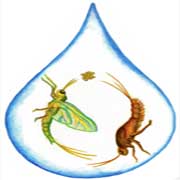By Theme:Arts and Literature | Campus Sustainability | Community Perspectives | Development | Economic Analysis | Ecosystem Analysis | Education | Energy | Environmental Justice | Food Systems | Geology of the Watershed | Green Architecture | Green Business | History of the Watershed | Invasive Species | Land Use Patterns | Public Policy | Recreation | Transportation | Water Quality
Ecosystem Analysis
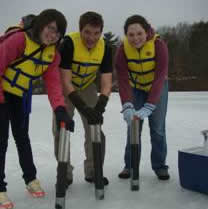 The Distribution and Accumulation of Copper in the Bottom Sediments of Loughberry
Lake, Saratoga Springs, NY
The Distribution and Accumulation of Copper in the Bottom Sediments of Loughberry
Lake, Saratoga Springs, NY
Noah Novotny, Leah Wohl-Pollack, and Whitney Eliot (2008)
Copper sulfate has been used for over 40 years in Loughberry Lake as an algaecide. This project analyzed copper concentrations in sediment samples extracted from cores taken from Loughberry Lake. We determined if and how copper has accumulated in the bottom sediemnts over time and related it to copper sulfate application history in order to better understand copper's possible impact on the lake ecosystem.
Full report is not available. Please contact Cathy Gibson for more information.
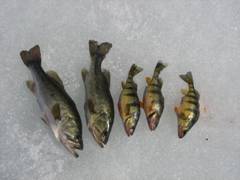 Copper Concentrations in Five Freshwater Species from Loughberry Lake, Saratoga Springs,
NY
Copper Concentrations in Five Freshwater Species from Loughberry Lake, Saratoga Springs,
NY
Charles Gouin and Matthew Helterline (2008)
We examined the concentration of copper in the tissue of five aquatic species in Loughberry Lake, and three species from Lake Lonely. The species belong to various trophic levels, allowing us to detect any evidence that copper is biomagnifying. We examined muscle and skin tissue separately from the organ tissue so that these concentrations could be compared.
Full report is not available. Please contact Cathy Gibson for more information.
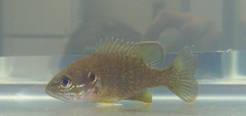 Impacts of Copper Sulfate on the Feeding Efficiency of Juvenile Bluegill Sunfish
Impacts of Copper Sulfate on the Feeding Efficiency of Juvenile Bluegill Sunfish
Elizabeth Stoner and Elizabeth H. White (2008)
Dissolved copper can damage the olfactory and visual systems of fish at low concentrations. We examined the impact of copper sulfate, a common algaecide, on the foraging behavior of juvenile sunfish. Foraging efficiency influences fish health and food web dynamics, and therefore can suggest changes in ecosystem functioning.
Full report is not available. Please contact Cathy Gibson for more information.
 The Impact of Turbidity on Sunfish Foraging Efficiencies
The Impact of Turbidity on Sunfish Foraging Efficiencies
Jon DeCoste '05, Doug Morin '07, Jorie Pollak '04 and Conor Taff '05 (2005)
We conducted a series of experiments to evaluate the impact of various turbidity levels on juvenile bluegill sunfish foraging efficiencies. We found that foraging efficiencies are highest at intermediate turbidity levels, and drop significantly at low and high turbidity levels. We hypothesize that the decrease in foraging efficiencies in clearer water is due to predator avoidance, while the decrease in foraging efficiencies at higher turbidity levels is due to the poor visual environment.
Full report is not available. Please contact Karen Kellogg for more information.
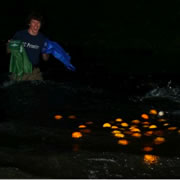 Distribution and Ecology of Riparian Invaders in the Upper Hudson Watershed
Distribution and Ecology of Riparian Invaders in the Upper Hudson Watershed
Emily Rollinson ’09, Dan von Allmen ’09, and Josh Ness, Assistant Professor of Biology (2008)
Japanese knotweed (Fallopia japonica) is a water-borne exotic weed currently invading the riparian zones in the United States and Europe. We mapped the distribution of knotweed in nine Upper Hudson watersheds, and discovered that invasions were more common in larger streams (third to fifth order) and along the depositional banks of meandering stream reaches. We attribute both patterns to within-stream increases in the delivery of plant fragments. We also found that knotweed-invaded riparian zones differed from their non-invaded counterparts, with fewer herbaceous species, fewer woody seedlings, and less light reaching the forest floor. These invasions may reconfigure riparian communities.
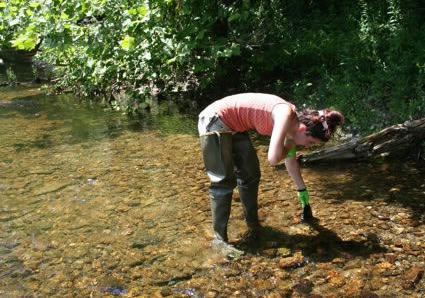 Impact of Invasive Diatom on Stream Food Web and Community Structure
Impact of Invasive Diatom on Stream Food Web and Community Structure
Hannah Harris ’10, Emily Stulik ‘10, and Cathy Gibson, Assistant Professor of Environmental Studies (2008)
In the summer of 2007, Didymosphenia geminata, an invasive algae also known as “rock snot” was found on the Batten Kill River near Salem, NY. Previous research has shown that invasions of D. geminata can alter the structure of the macroinvertebrate community by contributing to the decline of other species such as mayflies, stoneflies, and caddisflies. To determine the impact of the invasion on the macroinvertebrate community of the Batten Kill, we sampled four similar sites with varying levels of invasion. Both the diets and the community structure of D. geminata were analyzed. Preliminary results suggest that some species may be capable of limiting the growth of D. geminate through grazing, and that the presence of D. geminata, even at low levels, decreases the abundance of macroinvertebrates in the river.
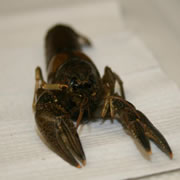 Concentration and Distribution of Copper in Crayfish in Loughberry Lake
Concentration and Distribution of Copper in Crayfish in Loughberry Lake
Benjamin Alley (2009)
Copper sulfate is added to Loughberry Lake to control algae. I examined the geographic distribution of crayfish copper concentrations in Loughberry Lake and looked for evidence of accumulation within the crayfish. Crayfish from three locations on the lake were analyzed for copper to examine geographic distribution, and five crayfish of various sizes were examined from one location to examine accumulation.
Full report is not available. Please contact Cathy Gibson for more information.
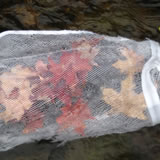 Breaking it down: The Influence of Relative Nitrogen and Phosphorus Availability
on Leaf Litter Decomposition and Macroinvertebrate Communities in Two Small Streams
within the Saratoga Lake Watershed
Breaking it down: The Influence of Relative Nitrogen and Phosphorus Availability
on Leaf Litter Decomposition and Macroinvertebrate Communities in Two Small Streams
within the Saratoga Lake Watershed
Alicea Cock-Esteb and Hannah Harris (2009)
When leaves fall into streams, they are incorporated into the food web through consumption by microorganisms and macroinvertebrates. Our study examined how the relative availability of nitrogen and phosphorous influenced the rates of leaf litter decomposition via macroinvertebrate communities and microbial respiration in two small, wooded streams in the Saratoga Lake Watershed. We found that a higher relative availability of nitrogen and phosphorous corresponds to higher decomposition rates although the macroinvertebrate community seems to be more influenced by other factors.
Full report is not available. Please contact Cathy Gibson for more information.
 Weather or Knot: The Impact of Natural and Anthropogenic Disturbances on Japanese
Knotweed
Weather or Knot: The Impact of Natural and Anthropogenic Disturbances on Japanese
Knotweed
Daniel von Allmen, Peter Leipzig-Scott, and Erin Kenison (2009)
Japanese knotweed is an aggressive invader of riparian habitats. Our study investigates how natural and anthropogenic disturbances, including flooding, human land use and natural stream channel migration, affect the distribution of knotweed. These disturbances had differing effects on knotweed presence. A large percentage of plants were damaged over winter months, which may contribute to plant fragmentation and subsequent dispersal.
Full report is not available. Please contact Cathy Gibson for more information.
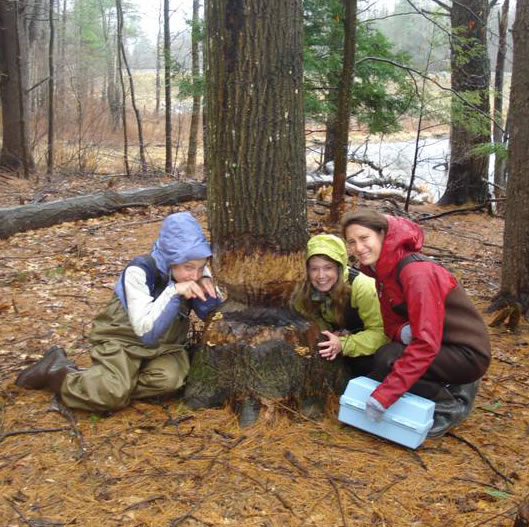 The Influence of Beavers on Sediment Storage and Stream Turbidity in the Saratoga
Lake Watershed
The Influence of Beavers on Sediment Storage and Stream Turbidity in the Saratoga
Lake Watershed
Stephanie Abrams, Lindsay Bourgoine, and Alexandra Furman (2009)
This study examines the repopulation of beavers within the Saratoga Lake Watershed through pond density and how their ecosystem engineering has geomorphically impacted water bodies. The three beaver ponds investigated stored large quantities of sediment and the amount of suspended particles decreased downstream of the ponds. Therefore, increases in pond density result in changes in the way sediment is stored in the watershed.
Full report is not available. Please contact Cathy Gibson for more information.
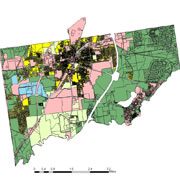 A Watershed Approach to Land Conservation in the City of Saratoga Springs, New York
A Watershed Approach to Land Conservation in the City of Saratoga Springs, New York
Dan Haro and Carolyn Raider (2010)
Saratoga is New York’s fastest growing county. Population increase leads to residential and commercial development, resulting in habitat degradation and fragmentation. Saratoga Springs provides conservation through its zoning ordinance, "the Green Belt." Our study identifies high priority sites to protect within Saratoga’s “Green Belt” conservation zone. We identify the least developed watersheds as well as watersheds with the highest percentage of forest, wetland, open water, and grassland/shrub habitats. We recommend replacing the current parcel-based approach to conservation with a more relevant and environmentally successful watershed approach. We also recommend additional protection for watersheds with a low percentage of development.
Full report is not available. Please contact Josh Ness for more information.
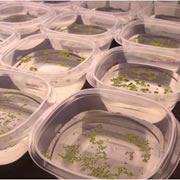 Phytoremediation of Nutrient-Controlled Water Using Duckweed and Water Fern
Phytoremediation of Nutrient-Controlled Water Using Duckweed and Water Fern
Dawn Harfmann and Jakob Schenker (2010)
Phytoremediation is a way to use plants to remove nitrogen and phosphorus in water
bodies, nutrients which could cause eutrophication. Duckweed, water fern, and a combination
of both plants were cultivated in varying nutrient environments and analyzed for nutrient
uptake patterns. These environments had nitrogen levels characteristic of eutrophic
water bodies and phosphorus levels characteristic of oligotrophic and mesotrophic
water bodies. Nitrogen concentrations decreased by up to 87% in the duckweed treatment.
Possible synergistic effects between the two species were observed, as the combination
treatment reduced nitrogen levels to 11% below expected values.
Katherine Bohn and Sarah Sproviero (2011)
Water quality is constantly fluctuating, and New York State’s monitoring resources are inadequate. In collaboration with the Saratoga County Stormwater Management Coordinator, we developed BioMAK, a citizen-based biomonitoring guide instructing volunteers how to use macroinvertebrate populations to assess Kayaderosseras Creek water quality. Ideally, data collected by community members will eventually supplement limited government data, while also educating citizens.
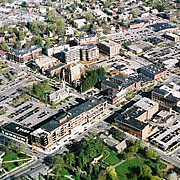 Promoting Environmental Sustainability Initiatives: The Role of a Chamber of Commerce
Promoting Environmental Sustainability Initiatives: The Role of a Chamber of Commerce
Kelly McDonnell and William Moseley (2012)
A significant, positive association has been found between environmental stewardship and economic growth. Taking this into consideration, our study focuses on the role of Chambers of Commerce in forwarding environmental sustainability initiatives. This study was informed by interviews with 20 Chambers of Commerce and interviews with Saratoga County Chamber members. Out research culminated in a series of recommendations for the Saratoga County Chamber of Commerce to promote environmental sustainability in Saratoga.
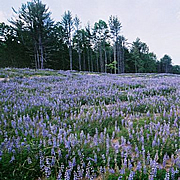 Keeping up with the Karners: Habitat, Population and Persistence of a Local Federally
Endangered Species
Keeping up with the Karners: Habitat, Population and Persistence of a Local Federally
Endangered SpeciesOlivia Berry and Tessa Leverone (2012)
One of the largest populations of the Karner Blue Butterfly, a federally endangered species, is located in the Saratoga Watershed. We synthesized five years of demographic and habitat data collected by The Nature Conservancy and NY-DEC. Our results demonstrate that habitat characteristics and existing population size can predict much of the variation in how sub-populations grow or shrink in size over time, and reinforce the importance of targeted and consistent management practices in the future.
 Economic Growth, Politics, and Comprehensive Planning
Economic Growth, Politics, and Comprehensive PlanningJosh Inaba, Katherine Rosman, and Leslie Velasquez (2014)
Saratoga Springs is challenged with planning for future development that balances growth and conservation of natural resources. We conducted a historical and qualitative analysis of the city’s comprehensive plans over the last 50 years and interviewed various stakeholders, and studied how the theory of sustainable development has been implemented. Despite conflicts between competing interests, the outcome of comprehensive plans and the work of local politicians have balanced economic, sustainability, and social goals.
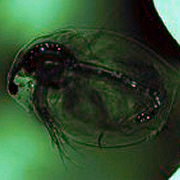 Distribution and consequences of microplastics, a new anthropogenically derived contaminant
in streams
Distribution and consequences of microplastics, a new anthropogenically derived contaminant
in streamsMargie Pfeffer and Jordan Stark (2015)
Microplastics are widespread in large water bodies including oceans, lakes and rivers. We sampled streams in small towns in Upstate New York to determine the breadth of microplastic pollution and the contributions of both point and nonpoint sources of microplastics. After demonstrating the presence of microplastics in these small systems, we exposed Daphnia magna (water flea) to microplastics to determine whether they could be incorporated into the food web or have negative health effects.
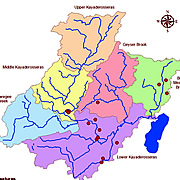 Urbanization in the Kayaderosseras Creek Watershed: Impacts on Stream Temperature
Urbanization in the Kayaderosseras Creek Watershed: Impacts on Stream TemperatureJessica Dunning, Zachary Gordon, and Alice Wu (2015)
Kayaderosseras Creek is a trout stream in Saratoga County, but trout are cold-water fish and increased urbanization in the watershed may be increasing stream temperature. We ran a thermal urban runoff model on 15 sites throughout the watershed. Percent impervious cover at the sites had a large impact on both runoff and stream temperatures. Low-impact development and other techniques for reducing runoff are needed to maintain trout habitat in the watershed.
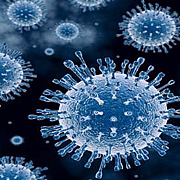 Sinister Superbugs Skulking in Streams?
Sinister Superbugs Skulking in Streams?Hannah Bachrach, Anna Gubbins, and Sarah Turner (2015)
Upstate New York has a history of industry dumping its heavy metal waste into streams. Active heavy metal pollution can lead to antibiotic resistance in stream microbial communities, but it is unknown if legacy heavy metal pollution can have the same effect. We grew stream bacteria on four different treatments to determine the effects of these legacy heavy metals and other urban pollutants on antibiotic resistance in stream bacteria and identified microbial community shifts.
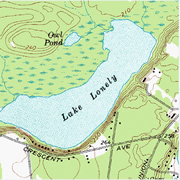 Nitrogen and sediment dynamics in wetlands and streams along an urbanization gradient
within the Lake Lonely watershed
Nitrogen and sediment dynamics in wetlands and streams along an urbanization gradient
within the Lake Lonely watershedBen Freiberg, Nicolas Graver, & Kat Klammer (2016)
The ability of wetlands to sequester or convert reactive nitrogen is an important control of anthropogenic nutrient inputs. We observed cool weather nitrous oxide flux, denitrification potential, nitrogen mineralization rates, and sediment patterns within two New York wetland streams. The N2O flux and N-mineralization rates had no significant relationships to temperature. The size of sediments and thus availability of denitrifying bacteria habitat may determine rates of microbial nitrate processing within wetland streams.
Report is not available. Please contact Karen Kellogg for more information.
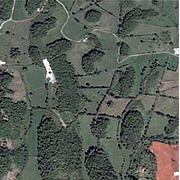 Forest fragmentation, ecosystem function, and community values within complex social
and natural landscapes
Forest fragmentation, ecosystem function, and community values within complex social
and natural landscapesJulia Boyer, Kaelen Clark, & Grant Bean (2016)
We assessed how community perceptions and adjacent land uses affect the functioning of forest fragments and their edges. Edge effects persisted beyond 50m into the fragment. Community members of Saratoga were concerned about protecting fragments for their ecosystem services, but were unclear on who has the power to protect them. We suggest that conservation of these fragments must be considered both a natural and social landscape issue.
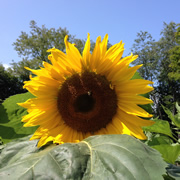 Lead-Contaminated Soils in Saratoga Springs and Hormone-Stimulated Phytoextraxtion
as a Potential Solution
Lead-Contaminated Soils in Saratoga Springs and Hormone-Stimulated Phytoextraxtion
as a Potential SolutionCharles Lovejoy & Una Semar (2016)
Lead-contaminated soils are pervasive in many urban settings. We tested lead concentrations in home-garden soils of Saratoga Springs residents. In the lab, we analyzed the effect of various hormone treatments on the ability of sunflowers to phytoextract lead. We found significant lead contamination in over half of the gardens sampled. Sunflowers treated with strigolactone had significantly elevated concentrations of lead in their tissues compared to the other hormone treatments and control group.
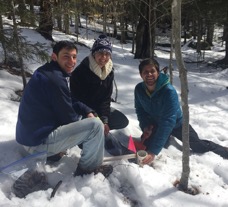 Road salt deposition and retention in the riparian zones: High impact in the High
Peaks?
Road salt deposition and retention in the riparian zones: High impact in the High
Peaks?
Daniel Casarella, Connor Christoffersen, and Jennifer Cristiano (2018)
Road salt (NaCl) application in the Adirondack Park (AP) is expected to increase with climate change. We assessed the impact of NaCl on riparian soils in the AP because riparian zones are vital to protecting AP waterways. We used soil samples from Johns Brook Tributary (JBT), which is not exposed to winter salting, and Cascade Brook (CB), which is. CB soils had higher Na and Cl concentrations. JBT had higher concentrations of available ammonium and phosphate. There were no statistically significant differences in soil macroaggregates or microbial communities.
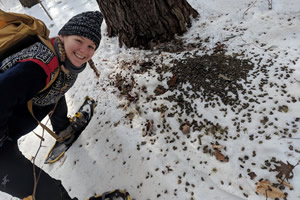
We set out to establish a baseline carbon inventory of Skidmore's unmanaged forested lands, 60 of which have been logged, in Stables, Kellogg, Homestead, and Compost parcels. We sampled aboveground (trees, deadwood, and leaf litter) and belowground carbon (soil 0-10cm & soil 10-20cm in 42 15m-radius plots throughout the parcels. We found that Stables and Kellogg held carbon densities above a baseline of common practice for the area, indicating the viability of a carbon sequestration project to reduce Skidmore's greenhouse gas emissions.
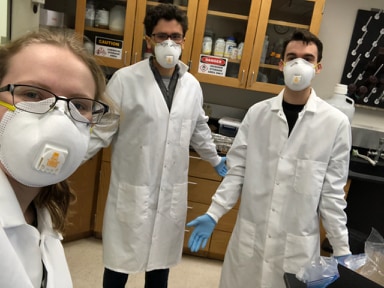
Skidmore’s former community garden contains unsafe lead levels and a remediation plan must be developed. We measured lead concentration in the garden at 0-10 cm and 10-20 cm. Average lead concentration was 630 ppm at 0-10 cm and 629 ppm at 10-20 cm. We recommend high-resolution mapping and selective excavation coupled with soil replacement and biostabilization. Additionally, fine-scale mapping could be used to reduce costs for other small-scale lead remediation projects.
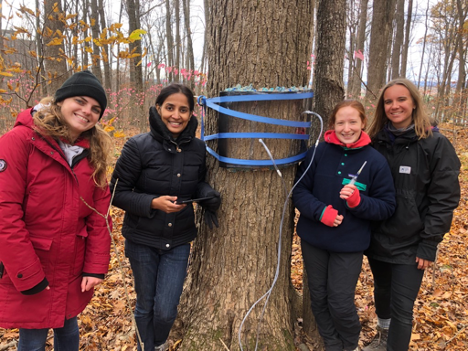 Tree Methane: A Silent but Deadly Threat
Tree Methane: A Silent but Deadly Threat
Kate Bjorklund, Freddie Klaus, Zoe Pagliaro (2020)
Trees are widely recognized as a globally important carbon sink. However, forest climate interactions are complex, and the relationship between forested ecosystems and methane, a potent greenhouse gas, is not well understood. Previous studies have used internal methane concentration measurements to model flux without direct evidence of linking the two. Our research investigates this relationship by comparing instantaneous stem concentrations and chamber-based stem flux measurements.
Paper is not available. For information, please contact the ESS Program Director.
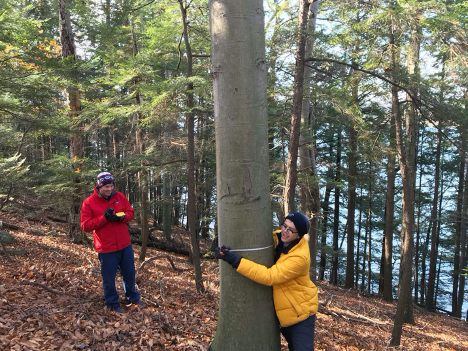 Under (and over) the dome: species distributions and aboveground-belowground relationships
on an Adirondack Island
Under (and over) the dome: species distributions and aboveground-belowground relationships
on an Adirondack Island
Sebastian Gatton and Samuel Sheppard (2020)
Forests provide numerous services to humans and the environment, but are also complex, dynamic systems subject to disturbance and heterogeneity. Geospatial techniques can be a useful tool to analyze these heterogeneous landscapes. One aspect of spatial statistics that has not been fully explored is the integration of high-resolution plant and soil data in forests. We explored how overstory tree species and soil properties were spatially correlated using aboveground point process data and belowground raster data.
Paper is not available. For information, please contact the ESS Program Director.
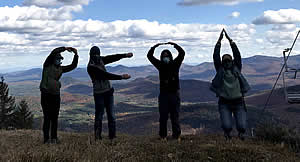 Yellow Snow Is the Least of Your Worries: The Presence and Persistence of PFOA on
Ski Hills in Upstate NY
Yellow Snow Is the Least of Your Worries: The Presence and Persistence of PFOA on
Ski Hills in Upstate NY
Jacob Adams, Gillian Brogan, Elle Ping & Sammi Smith (2021)
Perfluoroalkyl substances (PFAS) are detrimental to both human and environmental health. Many downhill ski waxes contain PFAS, as it reduces the friction between skis and snow. We collected soil, leaf, and snow samples from ski mountains in upstate NY to evaluate the presence and persistence of ski wax PFAS. Sample analyses could not sufficiently detect concentrations at or below the EPA threshold, and we could not draw definitive conclusions regarding ski wax PFAS in NY state.
Paper is not available. For information, please contact the ESS Program Director.
